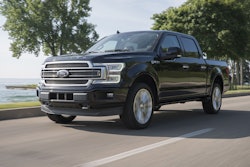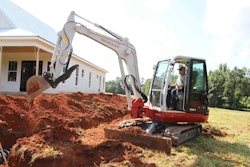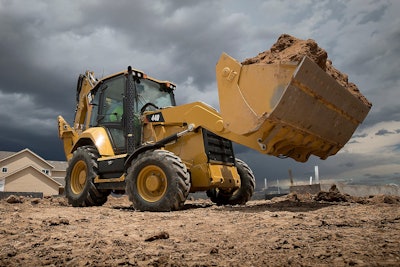 Cat 440 BHL
Cat 440 BHLA new 440 center-pivot backhoe joins Caterpillar‘s backhoe lineup, featuring advanced controls and a 25-percent backhoe lifting improvement over the 430F2. And improvements to the 17-foot Cat 450 deliver 15 percent more backhoe lifting capacity and 14 percent more loader capacity than the 450F – along with a new cab designed for operator comfort.
Breakout forces have also significantly increased on both the 440 and 450, and electronic control allows the new single-tilt loader arms to provide full-time parallel lift, say product specialists.
“We’ve been working on a lot of new features with this machine,” Todd Lange, who manages backhoe products sales and support for Caterpillar, told editors recently at Cat’s facility in Edwards, Illinois.
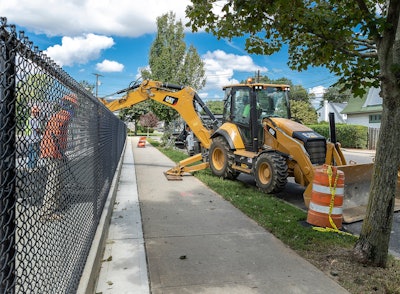 Cat 450 BHL
Cat 450 BHLDustin Adams, a product application specialist, says the 440 is designed to complement the existing 430F2 single tilt. It’s aimed to compete and win in the 15-foot size class, he says.
That’s thanks to a more balanced weight design and longer backhoe stabilizer legs that improve your operating stability. The new stabilizer systems can be equipped with available guards to prevent damage to the cylinder rod, and optional leg plate guards prevent material build-up on the underside of the stabilizer leg, Cat experts say.
The 17-foot digging depth classic – the 450F – had a successful run, and now the new 450 has arrived with upgraded emission equipment to meet the latest Tier 4 final standards, Adams says.
But the upgrades didn’t stop with the 450’s engine. Also improved is machine balance, stability, lift capability and overall performance, according to Adams.
The powertrains for both models are anchored by the Cat C4.4 ACERT engine that meets Tier 4 Final emissions standards by using a service-free SCR solution for improved operating efficiency.
Adrian Forrester, a market professional for backhoe loaders in Cat’s building construction products, pointed out in a walk-around that on the front end, they’ve improved the loader arms to give more power and lift.
“We’ve completely redesigned what we call single tilt loader arms. We no longer will have two style of loader arms that we did on the 430 and the (430) IT single tilt. You’ve got two lift cylinders and one single tilt,” says Forrester, pointing out that this gives good visibility and increased performance on the 440 and 450.
The 450 offers for the first time a coupler, he continues, so if you’ve got customers that want more versatility of the machine, they could quite easily and quickly change attachments.”
The low profile of the nose on these two new machines is adapted from that found on the F2 series styling, giving operators’ excellent visibility when operating the loader.
The two new backhoe models optimize engine speed and pump displacement for strong performance, according to Cat.
The standard Autoshift transmission comes with a sixth gear for improved road performance. There’s an optional Lock Up Torque converter for improved torque and efficiency on grades. New spring-applied hydraulically released (SAHR) brakes provide simplified operation of the parking brake.
Increased operator comfort
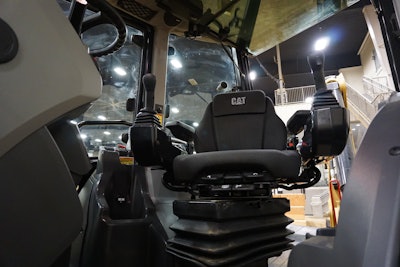
A completely reengineered hydraulic infrastructure for the operator station features seat-mounted controls to deliver a more comfortable operating position, reducing operator fatigue over extended shifts.
Electronic sensors imbedded in the new design automatically detect the seat position. The controls stay with the operator regardless of forward or reverse operation and eliminate the pilot control pods for backhoe operation, expanding legroom at the rear of the cab.
In a walk-around, Adams pointed out that the first thing you’re going to notice – and a game changer for Cat – are the seat-mounted controls designed after plenty of customer feedback.
“This machine now has controls that are attached to the seat and they travel with the operator whether they’re facing forward or reverse,” Adams explained.
“There’s a seat sensor that tells the machine when the operator is locked in and facing forward. They’re loader controls – all the features on their loader controls are live and they’re lefthand joystick is dead with the exception of a horn,” he said.
“As you spin around, when you lock into the rear, your backhoe controls become live, so you have full control of your backhoe when you’re locked into the back position. If you’re in between, your controls are dead, so there’s no accidental hitting it with your elbow or anything like that and give it unprompted or accidental commands.”
This control design enables the operator to sit at 45-degrees to the rear of the cab for increased operating comfort when truck loading and ditch clearing.
A redesigned digital display center, replete with soft keys, enables fast and efficient setting of critical machine functions plus clearer visibility of the fuel and water temperature gauges and tachometer.
In walk-arounds, the Cat experts also showed tool-free “flip up and flip out” cooling packages for easy access and maintenance.
Full-text diagnostic descriptions and instruction pop-ups aid in efficient machine operation and trouble-shooting. Up to 25 different user codes can be stored in the new models for operating security and quick pattern changes.
Improved load control
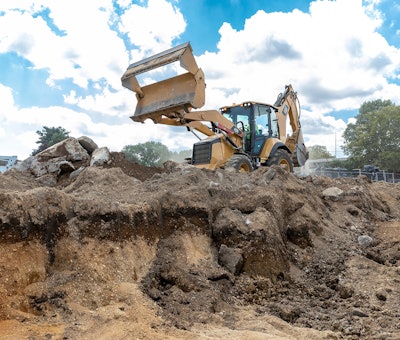 Cat 450 BHL
Cat 450 BHLBoth the 440 and 450 are built with common single-tilt loader arms. The design of the existing single-tilt loader arm configuration has been improved to improve lift capabilities and breakout performance by 15 percent, Adams and Forrester say.
Both true parallel lift and full rack angle control are now possible, thanks to electro-hydraulic controls and bucket positioner sensors, Adams says. The electrical sensors positioned at the tilt and lift arm enable parallel arm movement for increased material retention when lifting the loader bucket and safe handling of palletized loads.
In the cab, easy-to-set programmable kickout allows the operator to quickly establish upper and lower arm positioning for repetitive work like loading trucks. Additionally, return-to-dig limits can be set for efficient loader material excavation.
The 440 and 450 models can be ordered from the factory or easily field retrofitted with the optional loader quick coupler that delivers quick work tool changes and increased machine versatility using the Cat Integrated Tool Carrier (IT) system.
A new option: a single-tilt IT quick coupler, which can come from the factory or be mounted as an after-market field install kit.
After-market quick couplers for single-tilt loader arm configurations have traditionally involved a tradeoff between breakout forces and lift capacity once added. But the new Cat IT quick coupler and loader buckets let you maintain both breakout and lift capacity, Adams says.
The Cat Backhoe Loader with Integrated Tool Carrier (IT Coupler) will be the most versatile machine on the job site providing quick connection to a variety of Cat attachments, the specialists say.
Twist-to-connect quick disconnects for both the loader and backhoe arm attachments deliver fast connectivity under pressure.
The new 440 and 450 backhoe loaders come standard with Product Link systems that transmit critical machine operating data via VisionLink back to the office, providing alerts for machine fault codes, service reminders, fuel levels, and machine utilization, hours and location to improve fleet management.
In the rear, features include batteries with 1,000 cold-cranking amps, maintenance-free and tucked into a lockable side storage box with a standard quick disconnect switch for security.
These new backhoe loaders also feature adjustable auxiliary hydraulic flow to the work tool to efficiently operate powered attachments.



